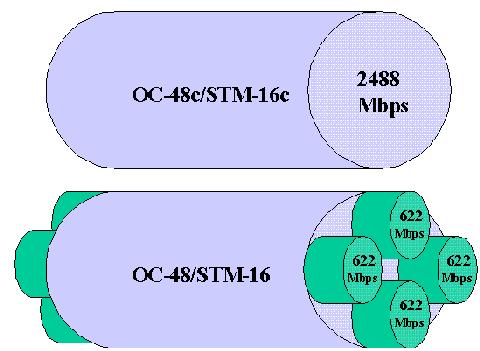
This segmentation within the 2.488 Gbps link increases
physical layer overhead, thereby limiting the individual link capacity
to just 622 Mbps, or less. The difference between OC-48 and OC-48c is analogous
to the difference between a DS-3 consisting of 28 separate DS-1s and a
clear channel DS-3 which can use the entire 45 Mbps in a single payload.

Comparing OC-48c/STM-16c and OC-48/STM-16.
The "c" in OC-48c/STM-16c provides the following benefits:
One of the key advantages of ATM is the ability to provision service with arbitrary capacity, unlike multiplexed systems which force services to be provisioned in fixed blocks (e.g., 64 Kbps) which often wastes bandwidth unnecessarily. A non-concatenated OC-48/STM-16 ATM interface breaks the available capacity into at least four 'pieces' before being provisioned, which leads to less efficient bandwidth utilization and unnecessary denial of service.
For example, a non-concatenated OC-48 interface may have 360 Mbps of total available capacity remaining, albeit parsed over four OC-12 links within. If a new service is requested at 100 Mbps, it may be denied since the 360 Mbps of available capacity is divided among four logical interfaces which each have only 90 Mbps of free capacity. On an OC-48c interface, the service could be provisioned, because the available 360 Mbps is contiguous.
One of the key applications of ATM is aggregation of lower speed interfaces, such as Gigabit Ethernet. An OC-48/STM-16 interface is incapable of supporting even a single gigabit-per-second connection, while an OC-48c/STM-16c interface can support multiple gigabit-per-second connections.
OC-48/STM-16 ports use at least four times the number of logical links of OC-48c/STM-16c ports. The number of logical and physical links is critical when building large networks, since more links make management and configuration more complex. With fewer logical links, there are fewer links to manage, to allocate connections across, to buffer, to statically route across, to discover via PNNI, to troubleshoot and isolate faults.
The following table summarizes these differences:
| Capability: | OC-48/STM-16 | OC-48c/STM-16c |
| Highest Capacity Flow: | 622 Mbps | 2,488 Mbps |
| Number of Non-buffered, Line-rate, Gbps Connections: | None (0) | Two (2) |
| Number of PNNI Table Entries: | Eight (8) | Two (2) |
| Minimum Number of UNIs: | Four (4) | One (1) |
| Minimum Cell Transmission Latency: | 708 nsec. | 177 nsec. |